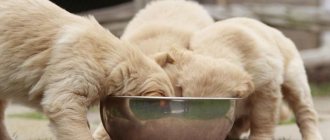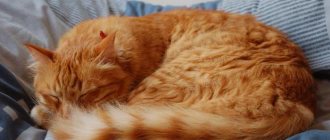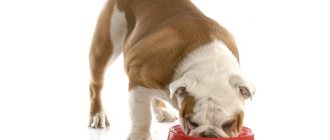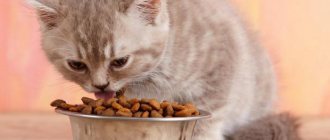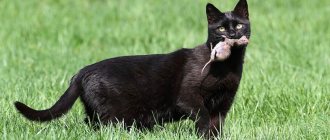High-quality nutrition for a cat is the key to its good health, so a good owner takes seriously the issue of choosing food for his pet. Sometimes circumstances force you to change the animal’s usual diet. At first glance, the question of how to switch a cat to another food is not difficult, but changing food for an animal is stressful. It is difficult for a cat to get used to a new diet; he refuses unfamiliar food. This issue must be approached thoroughly and very responsibly, because it is impossible to explain to an animal that a change in diet is necessary for its health. You need to be patient, because this will take time.
The animal has grown old
Like all living organisms on this planet, cats age and there is a risk of developing various diseases, including obesity. To avoid this, you need to choose a diet with a lower calorie content. It is better not to use food with a high protein content for an aging animal. But for very old cats, the opposite is true; due to poor absorption of food, the animal may develop vitamin deficiency, so you need to add more vitamins to the diet; protein is also necessary for such a cat.
The procedure for transferring an animal to pelleted food
Before switching your cat to one of the pelleted food options, you need to pay attention to its behavior. If your pet drinks little water during the day, you should not switch him to granules, as this will lead to frequent constipation and problems with urination. With a small amount of fluid consumed, the cat can replenish its deficiency from wet food.
If it is necessary to completely switch the animal to dry food, then at the initial stage it needs to be soaked. In the first few days, you can ignore the dose, since the granules will be mixed in minimal quantities with the main diet, but you still need to read the instructions. At the initial stage of mixing ready-made food, 10-15 granules can be added to the animal’s usual food. When adding pellets to daily food, they should be soaked in the same food. In the process of switching to dry food, the cat must drink 4 times more water than usual, so you need to constantly monitor the presence of clean liquid in your pet's drinking bowl.
If there is a lack of input balance, the animal may develop kidney disease. To completely switch a cat to pelleted food, it is necessary to remove some of the natural food in small proportions and add dry food instead. If the pet refuses the food offered, you need to change the manufacturer or add food without pre-soaking. On the tenth day, there should be no natural products left in the animal’s food. Your cat's diet should consist only of pelleted food.
After completely switching your pet to dry food, it is not advisable to pamper him with leftover food from your table. After ten days, the cat should eat exclusively dry food. You need to feed your pet with products from only one manufacturer that fits the age category of the animal. The dose is calculated based on the instructions pasted on the package.
Basic rules for switching a cat to another food
You can, of course, immediately give the animal new food, in 90% of cases the cat will simply refuse the new food, and this can also lead to an upset stomach and vomiting. So how can you correctly switch a cat to another food so as not to injure the animal or cause damage to the pet’s gastrointestinal tract? To prevent the animal from noticing a sudden change in diet, you need to add new food to the cat’s usual food in small portions for 10 days. This way you can check if your cat is allergic to a new food. If the animal has responded well to the new food and eats it with pleasure along with the old one, then you can gradually, by adding new food in small portions, remove the old food from the diet. On average, such a transfer is completed in 3-4 weeks. If the cat tolerates the new product well, the transfer time can be reduced to 2 weeks.
If for some reason your pet refuses new food, leaving it in the bowl, there is another way to switch your cat to another food, but it may seem very inhumane, although it is very effective. The essence of the method is to temporarily put the cat on a starvation diet. Having refused a portion of new food, the cat expects that he will now be fed his usual food, but nothing happens. After walking around looking unhappy, the hungry cat again approaches the bowl. After several such approaches, the cat eats the remains of the new food. The next day, we again dilute the favorite food with new food and do not give anything else until the bowl is empty. This diet is acceptable for 3-4 days. But if the pet continues to refuse new food, you should contact your veterinarian and ask how to switch the cat from one food to another, otherwise the animal may begin to develop a dangerous liver disease, which is fatal.
When switching an animal from natural food to dry food, or vice versa, you can give the cat prebiotics. They will help the gastrointestinal tract adapt to new food faster.
There are times when a sudden change is necessary, for example, when switching an animal to medicinal food, when an intolerance to components of the usual menu appears, or when there is a food allergy. In this case, there is a little trick on how to switch a cat to another dry food, which is to lightly pour fish broth over the dry food. This will attract the animal's attention. Do not forget to constantly monitor the condition of your pet, its behavior, appearance, so that there are no negative reactions. If any symptoms appear, contact your veterinarian immediately. A timely visit to a specialist will help preserve the life and health of your pet.
Important rules for transferring a pet to dry food from other types of food
When switching a cat to another type of food, you must follow several important rules:
- Taking into account the needs of the pet. The cat's preferences should be taken into account before offering another food. If your pet is a big fan of chicken, then it is unlikely that he will eat meat crackers. But indicating the type of meat on the package is not an advertising ploy, as many people think. A self-respecting manufacturer provides truthful information, which cannot be said about budget food. They use flavorings that are identical to natural ones. In addition, high-class industrial food is initially designed for the specific needs of the pet: to facilitate the removal of hairballs, for sterilized cats, for active cats. You should immediately take these nuances into account so that your pet receives a diet that suits its needs.
- Gradual means a gentle introduction of industrial feed into the diet. A sudden change is harmful and even destructive. It is enough to replace 1/10 of the usual portion with “crackers” and increase it daily by 1/10.
Every day you should replace only 1/10 of your pet’s usual diet with dry food.
- Time. The transfer from one type of feed to another should be carried out within 10–14 days. During this time, the cat will already taste new food. After this time, only the industrial product should be in the bowl.
- Unobstructed access to water. This is the most important rule when feeding commercial food.
The nuances of switching to dry food from different diets
Depending on what the cat ate previously, there are some nuances when switching it to dry food.
From wet industrial food
If the cat ate canned food, that is, wet industrial food, then everything is simple. In the first 2-3 days, crackers must be pre-soaked to the desired consistency. Gradually, soaking can be replaced with light moistening with the sauce from these canned foods. That is, mix the granules into a bowl, let it brew, and then offer it to the cat. At the last step, you can simply stir in either just the sauce or just the pieces. And after complete adaptation, leave only dry food.
From natural homemade food
The same rule applies here as with wet food. But cats are very suspicious animals and can easily recognize deception. Experts recommend starting with mixing canned food into natural food, and only then switching from wet industrial food to dry food. By the way, it will take the same amount of time: about two weeks.
There is another, simpler way: offer a dry food pellet as a treat. And specifically for a hungry pet. If no problems arise, then pour the food into the bowl during feeding hours.
My mother decided to switch her cat to dry food. I bought him a pack of Royal Canin. But the pet did not appreciate the taste or smell of the new food at all - he simply buried it with his paw, twitched his tail and walked away. Mom tried to soak it and mix it in, but the cat had no intention of even trying the new treat. Then they bought him a banal “Friskies”. It was he who ate him by both cheeks. But, of course, you can’t feed an animal with this product all the time. The next experiment was with Purina Van food. It fit perfectly too. And finally, the final product in this chain was Purina ProPlan food. Both the owner and the pet settled on it; it suits them in all respects. So if your cat refuses dry food, he may simply not like the taste or smell of this product. And never buy large packs of expensive food at once - there is a chance that you will have to feed it to street cats.
In case of partial replacement of other feeds with dry food
Many cats are not particularly mischievous and happily eat both wet and dry food. This is quite normal, especially if there is only one manufacturer. As a rule, problems with replacement do not arise here. The owner should only strictly decide at what hours he feeds dry food and at what hours he feeds wet food.
Video: rules for changing a cat's diet
Tips for feeding cats
Experienced veterinarians identify several basic rules when feeding cats:
- There is no need to mix dry food and canned food in one feeding.
- 2If the animal is fed on feed, it must be premium. Feeding an animal with expensive food is many times cheaper than spending money on treatment after using cheap analogues.
- There is no need to get carried away with wet food - if used frequently, they provoke obesity. They go as a dessert, sometimes you can pamper your beloved pet, but nothing more.
- Dry food lovers should always have a bowl of clean drinking water. Wet food consists of 70% water, but dry food contains much less water. In order for the animal to receive adequate nutrition from dry food, it needs to drink a lot. If a cat doesn't drink enough water, it will affect its well-being. If the condition worsens, you should urgently show the animal to a veterinarian.
- Without compelling reasons, there is no need to change feed frequently, and if this is a necessary measure, then follow the rules outlined above.
- Do not feed food strictly according to the norms indicated on the box. The cat will eat as much as she needs, she will leave the excess in the bowl, but starvation leads to a number of diseases.
- If you feed your cat natural products, then do not forget to add vitamins and minerals to the diet.
A veterinarian will help you perfectly balance your animal’s diet.
Advice from professionals
Hobbyists often turn to professional breeders for advice on how to best and quickly switch their pets to a more convenient food. Often, in the process of getting used to another product, cats and kittens lose weight. Such a reaction to an unusual type of food is not considered a deviation from the norm. As soon as the animal’s body adapts to the new type of food, the kitten (cat) will begin to gain weight again. In most cases, experts advise dividing the diet into 10 parts when switching an animal to dry food. For ten days, 1/10 of the food is constantly replaced with dry food. This process will lead to the fact that at the end of the tenth day the pet will painlessly switch to a completely different type of feeding without stress to the body.
To stimulate your pet's food intake, you can add catnip to the food. The smell of this plant attracts cats, and the animal will begin to absorb an unfamiliar type of food with a noticeably increased appetite.
Cat mint
When transitioning your pet to kibble, it is recommended to give him probiotics. These medications help normalize intestinal function and make it easier for your mustachioed pet to get used to new types of food. Probiotics can be purchased at any pet store or veterinary pharmacy, but before purchasing, you should consult with your veterinarian, since the use of these drugs is not necessary in all cases.
Why switch your dog to another food?
The decision to change the diet can be made either independently by an experienced and attentive dog breeder, or by a veterinarian.
The main reasons when there is a need to switch to another dry food are most often:
- suspicions of allergies, as evidenced by constant scratching and skin problems;
- excess or underweight (subject to optimal portion sizes and normal physical activity);
- loss of shine of the coat, its slight loss;
- lethargy, lack of interest in games, long walks;
- diarrhea and vomiting, constantly or at regular intervals, occurring shortly after feeding;
- features of physiology: age, illness.
If you doubt your knowledge of nutrition, contact your veterinarian to create a menu
If you are thinking about how to properly create a nutrition plan when switching your dog to dry food, it is best to do it as directed and under the supervision of a veterinarian. The doctor will be able to identify the reasons for the pet’s problems. He will recommend the most optimal type of food, which, depending on the pet’s condition and its problem, can be natural, canned or dry.
When is a feed change recommended?
Cats, unlike humans, do not require variety in their diet. On the contrary, constant changes in diet and experiments adversely affect the health of a mustachioed pet.
It is only necessary to switch a cat to another food for several reasons.
The kitten has become an adult
Up to 1 year old, an animal is considered a kitten. It grows actively, so it needs a lot of calories. In addition, microelements and protein are necessary for growth, formation of the skeleton, teeth, etc.
If you continue to feed an adult cat (from a year old) with food selected for a kitten, this will lead to obesity and an excess of microelements, which in some cases is worse than their deficiency.
Elderly age
Veterinarians have noted that, starting from the age of 7 years, age-related changes occur: physiological processes slow down, body functions fade away. Felines' appetite and behavior change, and activity decreases. It is recommended to switch older animals to a new food for the elderly.
Ideally, a pet is switched to new food twice - when it grows up and when it gets old.
Pregnancy and feeding kittens
During the period of bearing offspring and feeding, the food should be temporarily changed back to high-calorie food. Therefore, pregnant and lactating cats are given balanced kitten food.
You can increase the portions or feed in small doses, but often, which is better. For a lactating cat, it is advisable to dilute dry food with water, which promotes milk production.
The mother cat is transferred to the previous diet for adults approximately 1.5-2 months after lambing. By this time, practically no milk is produced.
Obesity or excessive thinness
Excess weight and its deficiency are corrected by selecting food with a certain calorie content.
Transferring the cat to new food and vitamins
A furry pet that appears in the house very quickly becomes a member of the family. And, of course, I want him to be healthy and delight his family with his purring for as long as possible. Each owner chooses for himself how and what to feed his cat.
But there are situations when, for one reason or another, you have to switch your cat to a new food. First, let's figure out why there may be a need to change your diet.
The reasons for switching a cat to a new food can be very diverse. Let's look at the main ones. 1. Age of the cat.
A kitten, an adult and an older animal need different amounts of nutrients. Kittens move a lot and grow quickly, but in an older pet, activity, on the contrary, decreases. Accordingly, feed should be selected taking into account the age and energy costs of the animal. 2. Pregnancy and feeding period in a cat.
During this period, your pet needs more vitamins and minerals, as well as more calories. 3. Obesity or underweight.
In this situation, it is necessary to adjust the caloric content of food, the amount of food consumed by the animal, or transfer the pet to special food that can solve weight problems.
4. Castration and sterilization.
Having lost one of its basic instincts, the cat directs its interest towards food and rest, and the cat’s activity decreases sharply. Moreover, there is a pattern between castration and an increased risk of developing urolithiasis in cats; therefore, it is recommended to switch your furry cat to a special diet for castrated and sterilized cats.
6. Previous operations on internal organs and digestive organs. After surgery, it may be difficult for the animal’s body to digest its usual food. In this regard, it is worth considering the option of transferring your pet to a special diet until complete rehabilitation.
Transferring the cat to a new diet
You need to gradually switch your cat to a new diet, replacing one food with another, since a sudden change in food can have an extremely negative impact on the health and quality of life of your pet. It is best to change your diet over 10 to 15 days.
In the first 3 - 5 days we give approximately 75% of the old food and about 25% of the new. Over the next 3 to 5 days, old and new food should be given equally. Then for another 3-5 days we feed in the proportion of 25% of the old diet and 75% of the new food.
And only then do we completely switch the cat to a new food.
We give old and new food at different times of the day. It is highly not recommended to mix different types of feed, as this increases the load on the kidneys. You also cannot mix different types of diet. For example, you can’t feed him natural food in the morning and dry food in the evening.
A faster transition of a cat from one food to another is allowed only if these foods belong to the same line or the same manufacturer and are similar in composition.
In emergency cases, a quick transition can be made if the pet’s health requires it, but this should only be done after consulting with a veterinarian. A cat and a cat have paralysis and atony of the bladder
What consequences can a cat experience when changing its diet?
It’s worth saying right away that if negative side effects occur when introducing a new food, you need to immediately remove it from your pet’s menu. 1. Since cats have a very sensitive digestive system, you may encounter various negative reactions. Diarrhea or, less commonly, vomiting may occur. 2.
Various allergic reactions may also appear in the form of skin rashes, hair loss and dullness, and purulent eyes.
3. Complete lack of interest in new food. A cat can go on a hunger strike for several days and not even go near the bowl.
Or, on the contrary, an increase in appetite, when your pet will literally sweep food off the plate and diligently demand more.
Scabies disease in cats
Cat disease eczema
American wirehair cat
Choosing a cat
About cats and for cats
As you can see, the process of changing your cat's diet is not as simple as it might seem at first glance.
Sometimes you have to go through several different manufacturers and try a lot of food before you can choose the one that suits your cat.
But after completing this labor-intensive procedure, your pet will delight you with its grateful purring for many years.
